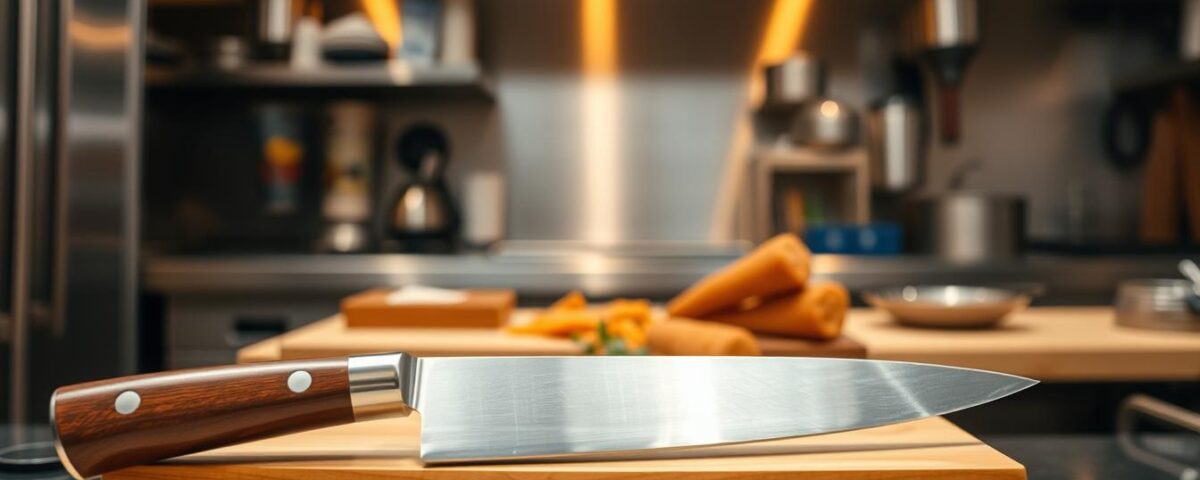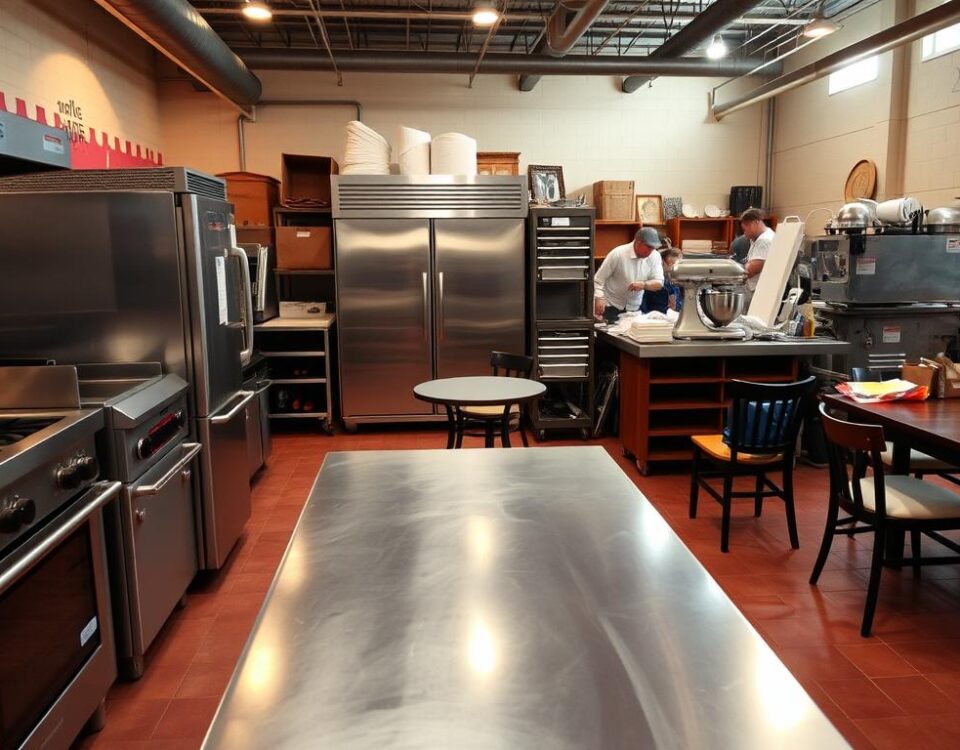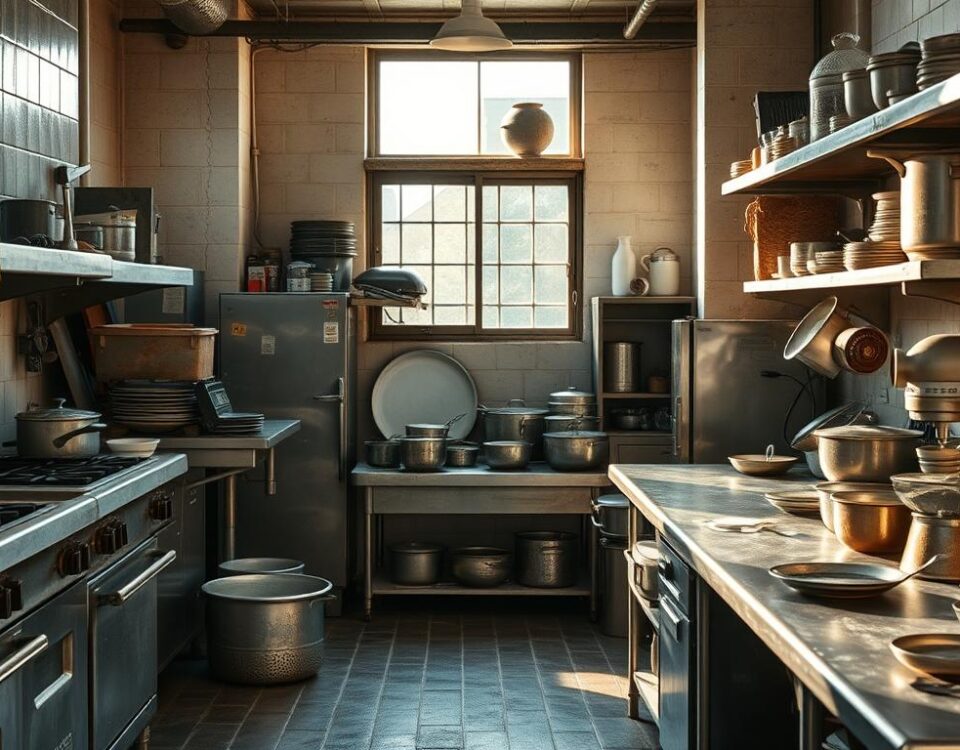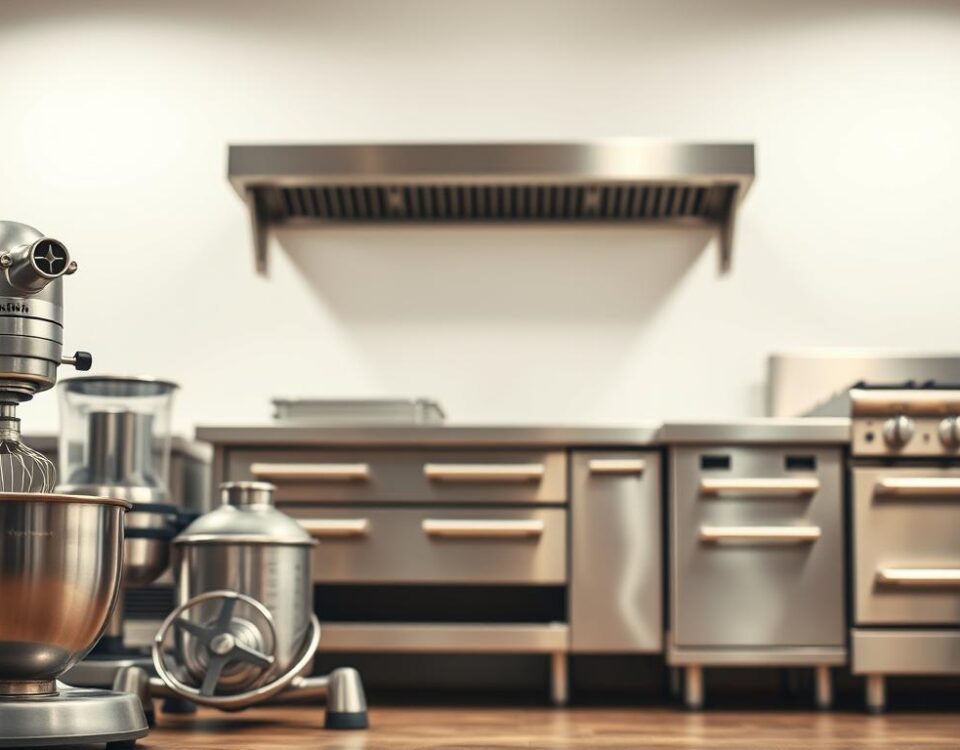
How to Start a Catering Business from Scratch and Succeed in 2025
June 28, 2025
Top Commercial Sous Vide Machines for Restaurants Revealed
June 29, 2025As I stood in my kitchen, surrounded by the chaos of meal prep, I realized that the right chef’s knife was more than just a tool – it was a game-changer. It’s the one piece of equipment that can make or break your cooking experience.
A staggering number of professional chefs agree that a quality knife is the foundation of any kitchen setup. With so many options available, choosing the best chef knife for your needs can be overwhelming.
After extensive testing and consultation with professionals, I’m excited to share my findings on the top knives that will elevate your cooking in 2025. What makes a great blade, and which ones are worth the investment?
Key Takeaways
- A quality chef’s knife is essential for any kitchen.
- The right knife can transform your cooking experience.
- Professional chefs rely on a few key characteristics when choosing a knife.
- Our testing process involved hands-on cutting tests and expert consultation.
- The top knives for 2025 offer a blend of performance, durability, and value.
The Essential Tool in Every Professional Kitchen
The importance of a high-quality chef’s knife in a professional kitchen cannot be overstated. Due to its importance in the kitchen, a chef’s knife warrants a splurge. We’ll tell anyone who can listen to save on their bread and paring knives and put that cash towards a good chef’s knife.
I’ve visited dozens of professional kitchens, and one thing remains constant: the chef knife is the most essential and personal tool a cook owns. Professional chefs often develop deep attachments to their chef knives, using them for 80% of their cutting tasks and maintaining them with religious dedication.
Unlike other kitchen tools that can be compromised on, a quality chef knife is where professional cooks invest their money, often spending hundreds of dollars on the right blade. The versatility of a chef knife is unmatched – from fine herb work to breaking down proteins, it’s the true workhorse of the kitchen that professional cooks rely on daily.
In professional settings, chefs often judge each other’s seriousness by the quality and condition of their primary knife, making it not just a tool but a badge of honor. While home cooks might get by with budget options, professional kitchens demand knives that can withstand 12+ hours of daily use while maintaining their edge and performance.
| Knife Feature | Importance in Professional Kitchen |
|---|---|
| Sharpness | Essential for precise cutting and safety |
| Durability | Critical for withstanding heavy daily use |
| Balance | Important for comfort and control during extended use |
A good chef’s knife is an investment in the quality of the cooking experience. It’s a tool that, when properly cared for, can last for years and become an extension of the chef’s hand. In the world of professional cooking, the knife is not just a tool; it’s a partner in creating culinary masterpieces.
What Makes a Great Chef Knife in 2025
A great chef knife is defined by several key elements that set it apart from others. The year 2025 has seen significant advancements in knife technology, with various designs and materials being used to enhance performance.
One of the primary considerations when selecting a chef knife is whether to opt for a Japanese or Western-style knife. The “chef’s” knife, as a shape, is originally a Western design. German-style chef’s knives are known for their thicker, heavier blades that curve significantly toward the tip, making them ideal for a rocking-chop motion.
Japanese vs. Western Chef’s Knives
Japanese chef knives are less curved and trend more in line with a French knife profile, making them more suited to a pulling stroke. In 2025, the line between Japanese and Western knife styles has blurred, with many manufacturers creating hybrid designs that combine the best elements of both traditions.
- Japanese chef knives feature thinner, harder blades that excel at precision cutting but require more careful maintenance.
- Western-style knives, particularly German models, offer more robust construction with thicker blades that handle heavy-duty tasks well.
Blade Materials: Stainless Steel vs. Carbon Steel
The debate between stainless steel and carbon steel continues in 2025. Carbon steel offers superior edge retention and sharpness but requires more maintenance to prevent rusting. Modern stainless steel alloys have improved dramatically, now offering much of the performance of carbon steel with significantly better corrosion resistance.
| Material | Edge Retention | Corrosion Resistance | Maintenance |
|---|---|---|---|
| Carbon Steel | High | Low | High |
| Stainless Steel | Medium | High | Low |
Handle Design and Comfort
Handle design has evolved beyond traditional Western and Japanese styles, with ergonomic innovations that reduce fatigue during extended use. The best chef knives of 2025 balance cutting performance with comfort, offering handles that accommodate multiple grip styles and provide proper knuckle clearance.
In conclusion, a great chef knife in 2025 is a result of careful consideration of blade material, style, and handle design. By understanding these key elements, professionals can make an informed decision when selecting their ideal chef knife.
How We Tested and Ranked These Chef Knives
To determine the best chef knives, I developed a rigorous testing methodology that evaluates each knife across multiple dimensions, from out-of-box sharpness to edge retention after extensive use.
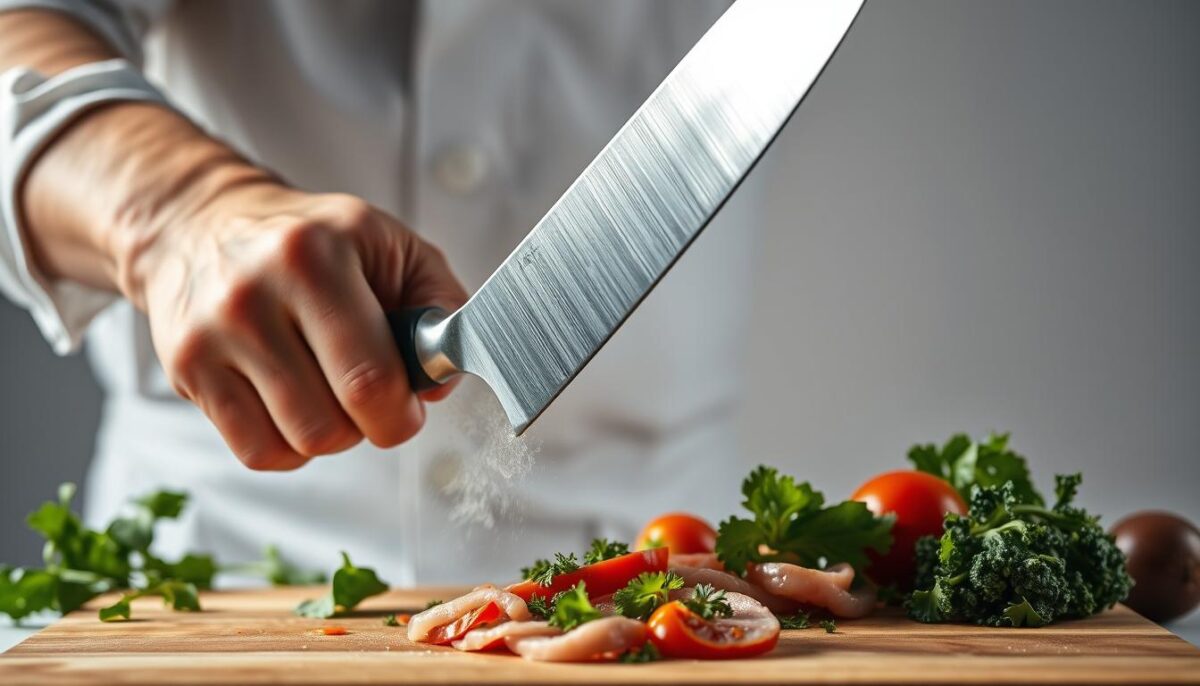
Our Testing Methodology
My testing began with objective measurements using a professional edge tester to quantify each knife’s sharpness before subjecting them to real-world cutting tasks.
- I performed standardized cutting tests with a variety of foods that challenge different aspects of knife performance: onions for general prep work, tomatoes for testing sharpness, carrots for hardness, and delicate herbs to assess blade fineness.
- Each chef knife underwent a durability assessment where I performed 100 cuts on a wooden cutting board, then retested sharpness to evaluate edge retention.
- The tests included: Edge Sharpness Test, Paper Cutting Test, Onion Dicing Test, Tomato Slicing Test, Carrot Cutting Test, Salmon Slicing Test, and Pineapple Dicing Test.
These comprehensive tests allowed me to assess the overall performance and durability of each knife under various conditions.
Evaluation Criteria
My evaluation criteria included several key factors to ensure a comprehensive assessment of each chef knife.
- Initial Sharpness: How sharp the knife was right out of the box.
- Edge Retention: How well the knife maintained its sharpness after extensive use.
- Comfort and Balance: How comfortable the knife felt in the hand, including its balance and weight distribution.
- Knuckle Clearance and Blade Geometry: How well the knife’s design facilitated smooth cutting motions.
- Overall Value: The knife’s performance relative to its price point.
By considering these factors, I was able to thoroughly evaluate each knife and determine which ones excelled in various areas.
Best Chef Knife 2025: Overall Top Pick
In our comprehensive review, the Mac Professional Hollow Edge 8″ Chef’s Knife is identified as the overall top pick for the best chef knife in 2025. This knife has consistently outperformed its competitors in precision cutting tests, maintaining its razor-sharp edge throughout weeks of heavy use in professional kitchen environments.
Mac Professional Hollow Edge 8″ Chef’s Knife
Overview
The Mac Professional Hollow Edge 8″ Chef’s Knife is a hybrid-style knife that combines the best qualities of both Western and Japanese chef’s knives. Its blade shape is designed to offer the precision of a Japanese knife and the durability of a Western-style knife. The molybdenum high-carbon steel used in its construction ensures that it remains sharp and is less brittle than traditional Japanese knives.
Pros
This knife has several advantages that make it stand out. The hollow edge design along the blade creates small air pockets that reduce friction and prevent food from sticking during cutting tasks. Additionally, the Pakkawood handle provides excellent grip even when wet, with perfect balance that reduces hand fatigue during extended prep sessions.
Cons
While the Mac Professional Hollow Edge 8″ Chef’s Knife is an exceptional tool, it is not without its drawbacks. The $145 price point may be considered expensive by some, although it represents a best value in its class, offering professional-grade performance that will serve both home cooks and professionals for many years.
Features
The key features of this knife include its molybdenum high-carbon steel blade, which holds an exceptional edge, and its hybrid blade design, which offers the perfect balance between Japanese precision and Western durability. The slightly curved edge accommodates both rocking and push-cutting techniques, making it highly versatile.
Best Western-Style Chef Knife
If you’re looking for a Western-style chef’s knife that embodies the German knife-making tradition, look no further than the Wüsthof Classic. This knife is characterized by its robust construction and excellent balance, making it a top pick for any serious chef.
Wüsthof 8-Inch Classic Chef’s Knife
Overview
The Wüsthof 8-Inch Classic Chef’s Knife is a testament to the brand’s commitment to quality and craftsmanship. With its high-carbon stainless steel blade and full-tang construction, this knife is built to last. The classic triple-riveted handle design provides a secure grip in various cutting positions.
Pros
This knife excels at heavier-duty tasks, easily handling dense root vegetables and even light bone work without concern for chipping. The pronounced curve of the blade is perfect for rock chopping herbs and garlic. Additionally, the knife’s edge retention is excellent, maintaining a serviceable edge even after weeks of heavy use.
Cons
While the Wüsthof 8-Inch Classic Chef’s Knife is a top-notch knife, it does have some drawbacks. The substantial weight (8.5 ounces) can cause fatigue during lengthy precision cutting sessions. Additionally, the handle design, while classic, may be slightly less comfortable for pinch grips than some modern designs.
Features
The Wüsthof 8-Inch Classic Chef’s Knife features a forged high-carbon stainless steel blade with a full-tang construction, providing exceptional durability and balance. The classic triple-riveted handle design ensures a secure grip, while the pronounced curve of the blade makes it perfect for rock chopping herbs and garlic.
Best Japanese Chef Knife
The Misono UX10 Chef’s Knife stands out as a premier choice for professional chefs and serious home cooks alike. With its razor-sharp blade and nimble design, this Japanese chef knife is designed to deliver exceptional performance.
Misono UX10 Chef’s Knife
The Misono UX10 is a masterclass in precision and craftsmanship. Its 8-inch chef knife blade is made from high-quality Swedish steel, known for its stain resistance and ability to hold a sharp edge.
Overview
This chef knife is designed for precision and ease of use. The UX10’s asymmetrical 70/30 bevel edge provides superior cutting performance, making it ideal for tasks that require finesse, such as dicing onions or slicing smoked salmon.
Pros
- The Misono UX10’s exceptional lightness and balance make it the most nimble and precise Japanese chef knife tested.
- The blade comes razor-sharp out of the box, effortlessly producing paper-thin slices of vegetables and proteins.
- The UX10’s asymmetrical edge provides superior cutting performance, though it requires more specialized knowledge to maintain.
Cons
- The UX10’s steel is difficult to sharpen, making it less ideal for beginners.
- The thin, lightweight handle may feel too slim for those with larger hands.
- At around $200, this chef knife represents a significant investment, though its performance justifies the price for serious cooks.
Features
- The UX10 features a high-carbon Swedish steel blade that is both durable and resistant to stains.
- The 8-inch chef knife is designed for precision tasks, such as fine dicing and slicing delicate proteins.
- The thin, lightweight handle provides excellent control, though it may not be comfortable for everyone.
Best Value Chef Knife
After testing numerous chef knives, I’m excited to share my top pick for the best value chef knife. The Victorinox Swiss Classic 8″ Chef’s Knife stands out for its exceptional performance and affordability.
Victorinox Swiss Classic 8″ Chef’s Knife
Overview
The Victorinox Swiss Classic 8″ Chef’s Knife is a former budget pick that continues to impress. Priced around $60, it offers 80% of the performance of more expensive knives, making it an excellent value for the price. With a nonslip plastic handle and a sharp stainless-steel blade, this knife is both functional and durable.
Pros
This knife has several advantages that make it a top choice:
- Excellent performance-to-price ratio
- The stamped stainless steel blade takes and holds an edge well
- Lightweight design and slightly curved blade profile for versatile cutting techniques
- Ergonomic handle design with non-slip texture for superior grip
- Durable construction that suggests long-term use
Cons
While the Victorinox Swiss Classic 8″ Chef’s Knife excels in many areas, there are a few drawbacks:
- The Fibrox handle lacks aesthetic appeal compared to wood or composite materials
- Some users may find the plastic handle less comfortable than other materials
Features
The Victorinox Swiss Classic 8″ Chef’s Knife boasts several key features that contribute to its value:
- Ultra-sharp stainless steel blade for precise cutting
- Slightly rounded blade for comfortable rocking motion
- Nonslip plastic handle for secure grip
- Lightweight design for reduced fatigue during extended use
Best Budget Chef Knife Under $50
The Mercer Culinary Renaissance Chef’s Knife proves that you don’t have to spend a fortune to get a high-quality chef knife. For its price, this knife offers a lot: high-carbon steel, full-tang construction, and high-quality handle scales.
Mercer Culinary Renaissance Chef’s Knife
Overview
The Mercer Culinary Renaissance Chef’s Knife is a standout in its class, offering features typically found in more expensive knives. High-carbon stainless steel and a full-tang construction make it a durable option for any kitchen.
At under $50, it’s an exceptional entry point for home cooks looking to upgrade from bargain-bin knives. The knife performed very well in our cutting tests, only slightly lagging behind more expensive winners.
Pros
This knife has several advantages that make it a great choice for budget-conscious cooks:
- I was genuinely surprised by how well the Mercer Culinary Renaissance Chef’s Knife performed in my testing, offering features typically found in knives costing twice as much.
- The full-tang construction and forged bolster provide excellent balance and durability, giving the knife a premium feel during use.
- The high-carbon stainless steel blade takes a sharp edge and maintained it reasonably well throughout my testing.
- The comfortable ergonomic handle with its triple-riveted design provides a secure grip even during extended cutting sessions.
Cons
While the Mercer Culinary Renaissance Chef’s Knife is an excellent value, it’s not without its drawbacks:
- It requires more frequent sharpening than premium models.
- During side-by-side testing with much more expensive knives, the Mercer showed slight disadvantages in edge retention and precision cutting.
Features
The Mercer Culinary Renaissance Chef’s Knife boasts several key features that make it a compelling choice:
- High-carbon stainless steel blade for durability and sharpness.
- Full-tang construction for added strength and balance.
- Triple-riveted ergonomic handle for comfort and grip.
- Perfectly balanced at the bolster, making it effective for various cutting tasks.
This knife is widely used in culinary schools across America, speaking to its reliability and value proposition for those learning proper knife skills.
Best Hybrid-Style Chef Knife
In the world of chef knives, the Shun Classic 8-Inch stands out as a masterclass in hybrid design, blending the precision of Japanese craftsmanship with Western-style functionality. This knife is designed to excel in both precision tasks and the rocking motion favored in Western cooking techniques.
Shun Classic 8-Inch Chef’s Knife
Overview
The Shun Classic 8-Inch Chef’s Knife is a testament to hybrid knife design, merging the best features of Western and Japanese knives. Its razor-sharp edge glides through ingredients with ease, making it a joy to use for any cooking task.
The knife’s design combines a curving belly with a traditional Japanese wa-style handle, making it comfortable for a variety of grips and cutting motions.
Pros
The Shun Classic 8-Inch Chef’s Knife boasts several key advantages:
- Versatility: Excels at both precision tasks and rocking motions.
- Exceptional Sharpness: Cuts through ingredients with zero resistance.
- Comfortable Design: Pakkawood handle provides grip and comfort.
- Aesthetic Appeal: Damascus steel pattern adds visual appeal.
Cons
While the Shun Classic 8-Inch Chef’s Knife is an exceptional tool, there are a few considerations:
- Investment: Priced around $150, it’s a significant investment.
- Maintenance: Requires proper care to maintain its edge and finish.
Features
The Shun Classic 8-Inch Chef’s Knife is equipped with several standout features:
- VG-MAX Cutting Core: Surrounded by 68 layers of Damascus steel for exceptional edge retention and corrosion resistance.
- Hammered Tsuchime Finish: Adds to the knife’s aesthetic appeal and helps prevent food from sticking.
- D-Shaped Pakkawood Handle: Provides comfort and control during use.
Best Artisan-Made Chef Knife
The art of crafting a chef knife has reached new heights with artisan-made knives like the Middleton Made Echo 8-Inch Chef Knife. This exceptional chef knife is designed by South Carolina-based bladesmith Quintin Middleton and his apprentices, showcasing a blend of traditional craftsmanship and modern functionality.
Middleton Made Echo 8-Inch Chef Knife
The Middleton Made Echo 8-Inch Chef Knife is a masterpiece that combines exceptional craftsmanship with outstanding performance. Its handle is made from dymalux, a dyed birch veneer that not only adds to its aesthetic appeal but also provides a comfortable grip.
Overview
This 8-inch chef knife features a forged stainless steel blade with a hybrid shape, making it versatile for both rocking and slicing motions. Our testers appreciated the feel of this knife, noting its deceptively lightweight design and the notch at the back of the blade that makes it comfortable to grip.
Pros
The Middleton Made Echo 8-Inch Chef Knife has several advantages:
- Exceptional craftsmanship and performance
- Unique dymalux handle
- Versatile hybrid blade shape
- Comfortable grip due to ergonomic design
Cons
While the Middleton Made Echo 8-Inch Chef Knife is an outstanding product, it does come with a premium price tag of around $240. However, the quality and performance justify the investment.
Features
The knife boasts an AEB-L stainless steel blade that takes an incredibly sharp edge and maintains it remarkably well. Its hybrid profile balances Western and Japanese design elements, making it suitable for a variety of cutting tasks.
Best Carbon Steel Chef Knife
In the world of culinary arts, the carbon steel chef knife stands out for its exceptional cutting performance and edge retention. I’ve had the opportunity to test numerous carbon steel knives, and the Wüsthof Carbon Steel Chef’s Knife stands out as the perfect introduction to this traditional blade material for 2025.
Wüsthof Carbon Steel Chef’s Knife
Overview
The Wüsthof Carbon Steel Chef’s Knife is a masterpiece that combines traditional carbon steel benefits with Wüsthof’s renowned German craftsmanship. This full-tanged blade had great balance and leverage, and a rounded belly that allowed for a nice rock-chop motion. The knife develops a beautiful patina with use, which not only adds character but also provides some protection against reactivity and corrosion.
Pros
Exceptional Cutting Performance: The high-carbon blade demonstrated exceptional cutting performance, slicing through dense vegetables with minimal resistance and producing cleaner cuts than many stainless competitors. Carbon steel offers significant advantages over stainless – I found this knife takes a noticeably sharper edge and maintains it longer than comparable stainless models.
The full-tang construction and triple-riveted handle provide the durability and balance that Wüsthof is known for, making this a knife that could last generations with proper care.
Cons
While the Wüsthof Carbon Steel Chef’s Knife excels in many areas, it requires more maintenance than stainless steel knives. It needs prompt cleaning and drying after use, especially when working with acidic foods. For cooks willing to embrace the minor additional maintenance, I found the superior cutting performance and edge retention of this carbon steel blade well worth the extra effort.
Features
The Wüsthof Carbon Steel Chef’s Knife boasts a high-carbon steel blade that is precision-forged for exceptional sharpness and durability. The full-tang construction ensures balance and leverage, making it comfortable to use for extended periods. The triple-riveted handle provides a secure grip and adds to the overall durability of the knife.
Best Lightweight Chef Knife
The Global Chef’s Knife stands out as a premier choice for those seeking a lightweight chef knife in 2025. Its unique design and exceptional balance make it an ideal tool for both professional chefs and home cooks.
Global Chef’s Knife
The Global Chef’s Knife is renowned for its innovative design and exceptional performance. Weighing in at just 5.8 ounces, it’s significantly lighter than many Western-style chef knives, making it perfect for cooks who experience hand fatigue or prefer a more agile blade.
Overview
This knife features a one-piece stainless steel construction that creates an exceptionally nimble cutting experience. The lightweight design, combined with its razor-sharp edge, allows for precise cuts with minimal effort.
Pros
The Global Chef’s Knife offers several advantages, including its exceptional lightness, precise cutting capability, and hygienic design. The sand-filled hollow handle provides perfect balance, while the CROMOVA18 stainless steel blade remains stain-resistant and durable.
Cons
While the Global Chef’s Knife excels in many areas, it does have some drawbacks. The metal handle can be slippery, especially when wet, and may not be ideal for individuals with larger hands.
Features
The Global Chef’s Knife boasts several notable features, including its one-piece stainless steel construction, sand-filled hollow handle, and CROMOVA18 stainless steel blade. These elements combine to create a knife that is both functional and durable.
In conclusion, the Global Chef’s Knife is an outstanding choice for those seeking a lightweight chef knife. Its unique design, exceptional balance, and razor-sharp edge make it a valuable addition to any kitchen.
Best Chef Knife for Beginners
Beginners often find themselves lost in the variety of chef knives available, but there’s one that stands out as an ideal starting point. For those new to cooking, a good chef knife can significantly enhance their kitchen experience.
Tojiro DP Gyuto
The Tojiro DP Gyuto is highly recommended for beginners due to its exceptional quality and value. It features a traditional Japanese gyuto shape with a rounded sheep’s foot drop point tip, ideal for slicing.
Overview
The Tojiro DP Gyuto is a versatile chef knife that combines the benefits of Japanese and Western designs. It’s made with high-quality materials and craftsmanship, making it an excellent choice for beginners.
Pros
Exceptional Sharpness: The Tojiro DP Gyuto arrives sharp out of the box, making it ready to use. Its VG-10 core provides excellent edge retention. Value for Money: Priced around $100, it offers performance comparable to more expensive knives.
Cons
Some users might find the handle style takes getting used to, although it’s designed for comfort and balance. The blade is carefully crafted for durability.
Features
San Mai Construction: This three-layer construction includes a high-carbon VG-10 core, providing excellent edge retention and durability. Full-Tang Construction: Enhances the knife‘s balance and reduces the risk of the blade separating from the handle.
The Tojiro DP Gyuto has been praised by both beginners and professional chefs for its performance and value. It’s a great introduction to high-quality Japanese chef knives.
How to Care for Your Chef Knife
Proper care is essential to extend the lifespan of your chef knife. As someone who has maintained professional kitchen knives for over a decade, I can attest that the right care makes all the difference in both performance and longevity.
Proper Cleaning and Storage
I’ve learned that the cardinal rule for maintaining a chef knife is to never put it in the dishwasher. The harsh detergents, high heat, and jostling with other utensils can quickly damage both the edge and handle of your knife. Instead, I always hand wash my chef knife immediately after use, especially after cutting acidic foods like tomatoes or citrus that can cause discoloration or even corrosion on high-carbon steel blades.
Proper storage is also crucial. I recommend using either a magnetic knife strip, a wooden knife block, or individual blade guards to protect the edge from damage and prevent accidents.
| Storage Method | Benefits | Drawbacks |
|---|---|---|
| Magnetic Knife Strip | Easy access, keeps knives organized | May require installation, not suitable for all kitchen setups |
| Wooden Knife Block | Traditional, aesthetically pleasing, protects blades | Can take up counter space, requires regular cleaning |
| Individual Blade Guards | Protects blades, portable | Can be lost, adds extra items to manage |
Sharpening and Maintenance
For edge maintenance, I use a honing rod for Western knives or a ceramic honing rod for harder Japanese steel before each use to realign the microscopic edge. Even the best knives need proper sharpening every 3-6 months depending on use. You can either learn to use whetstones or find a reputable professional sharpening service.
When sharpening Japanese knives with asymmetrical bevels, it’s crucial to maintain the correct angles, typically 15-17 degrees on one side and 10-12 on the other. I’ve also noticed that wooden cutting boards are significantly gentler on knife edges than plastic, glass, or bamboo surfaces.
By following these care and maintenance tips, you can keep your chef knife in top condition, ensuring it remains a reliable tool in your kitchen for years to come.
Common Chef Knife Mistakes to Avoid
As I reflect on common mistakes home cooks make with their chef knives, it’s clear that awareness is key to improving technique. Many home cooks unknowingly make simple mistakes that can significantly impact the performance and longevity of their chef knife.
One of the most common errors is using the wrong cutting surface. Cutting on glass, marble, or granite can destroy the knife’s edge almost immediately. Instead, opt for a wooden or plastic cutting board to preserve the blade.
- Improper storage is another frequent mistake. Tossing knives loosely in a drawer can cause them to bang against other utensils, chipping the edges and damaging handles.
- Many cooks mistakenly use their chef knife for tasks it’s not designed for, such as opening packages or cutting through bones. Specialized tools exist for these purposes.
- Using a sawing motion with the knife can quickly dull the edge. Instead, use forward slicing motions or rock the blade depending on its design.
- Attempting to catch a falling knife is a dangerous mistake. Always let it fall and step back to avoid serious injury.
- Neglecting regular honing is another common mistake. This simple 10-second maintenance step before each use can significantly extend the time between sharpenings.
- Using excessive force when cutting not only increases the risk of accidents but also indicates a dull blade that needs sharpening.
- The “scrape and scoop” technique, where ingredients are gathered by scraping the knife across the cutting board edge-first, is particularly damaging to the knife’s edge.
By being aware of these common mistakes, home cooks can take steps to improve their technique, maintain their chef knives, and ensure a safer cooking experience.
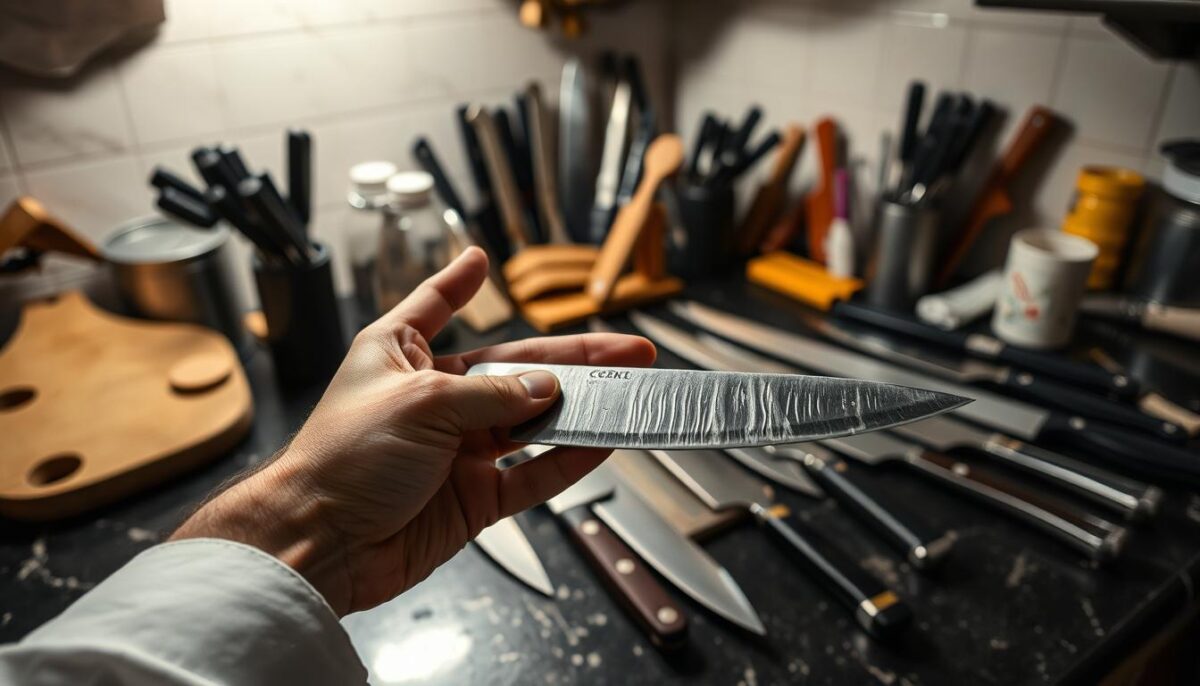
How to Choose the Right Chef Knife for Your Needs
Selecting the ideal chef knife is a personal journey that depends on various factors, including your cooking style, hand size, and budget. When choosing a chef knife, it’s essential to consider what works best for you, as personal preference plays a significant role in determining the best fit.
To start, I recommend physically holding different styles of chef knives before making a purchase. This allows you to assess the comfort, weight, and balance of the knife in your hand. Hand size significantly impacts knife preference, with larger hands often preferring wider handles and heavier knives, while smaller hands tend to favor lighter, more nimble blades.
Your primary cooking style should also influence your choice of chef knife. For instance, if you primarily chop herbs and vegetables, a lighter Japanese-style knife might be ideal. On the other hand, if you frequently break down larger ingredients, a sturdier Western design might be more suitable.
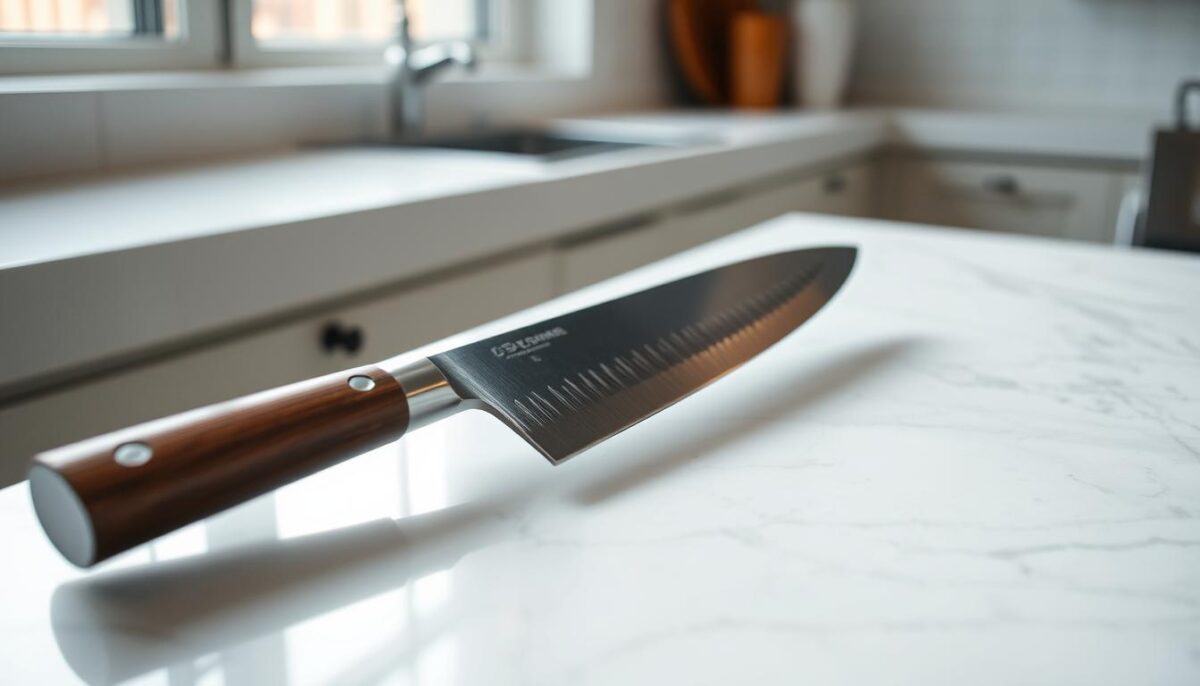
Budget is another crucial consideration, but it’s essential to think of a quality chef knife as a long-term investment that will serve you daily for many years. For home cooks new to quality knives, I often recommend starting with a versatile hybrid-style knife that combines elements of both Western and Japanese designs.
| Knife Type | Ideal For | Key Features |
|---|---|---|
| Japanese-style | Chopping herbs and vegetables | Lightweight, sharp blade |
| Western-style | Breaking down larger ingredients | Sturdy, durable construction |
| Hybrid-style | Versatile cooking tasks | Combines Western and Japanese features |
Additionally, consider your willingness to maintain your knife. Carbon steel requires more immediate care after use, while stainless options are more forgiving for busy home cooks. Lastly, don’t overlook the importance of blade length – an 8-inch chef knife is the most versatile size for most home kitchens.
Conclusion
After reviewing dozens of chef knives, I’m excited to share my top picks for 2025 that cater to various cooking needs and budgets. The Mac Professional Hollow Edge 8 remains my overall top recommendation, offering the perfect balance of sharpness, durability, comfort, and value that will satisfy both home cooks and professionals.
Investing in a quality chef knife is one of the most impactful purchases you can make for your kitchen – it transforms daily cooking from a chore into a pleasure. While my testing identified clear standouts in each category, I recognize that knife selection ultimately comes down to personal preference and cooking style.
For those just beginning their culinary journey, I recommend starting with either the Victorinox Swiss Classic or Mercer Renaissance – both offer excellent performance at accessible price points. Serious home cooks looking to elevate their kitchen experience should consider the Mac, Wüsthof Classic, or Shun Classic, depending on their preference for Japanese or Western styles.
Remember that even the best knife is only as good as its edge – regular maintenance and proper care are essential regardless of which knife you choose from this guide. I hope this comprehensive guide helps you find the perfect chef knife for your needs – the right blade will become an extension of your hand and a trusted kitchen companion for years to come.
By choosing one of these top picks, you’re investing in a quality tool that will enhance your cooking experience. Whether you’re a professional chef or a home cook, the right chef knife makes all the difference in the kitchen.
FAQ
What is the ideal blade material for a chef knife?
The choice between stainless steel and carbon steel depends on personal preference. Stainless steel is resistant to corrosion, while carbon steel offers exceptional sharpness and edge retention.
How do I maintain the sharpness of my chef knife?
Regular sharpening and proper storage are essential. I recommend using a sharpening stone or whetstone to maintain the edge.
What is the difference between a Japanese and Western-style chef knife?
Japanese knives tend to be lighter, with a more angled edge, while Western-style knives have a more curved profile and a thicker spine.
Can I put my chef knife in the dishwasher?
It’s generally not recommended, as high heat and harsh detergents can damage the blade or handle. I prefer to hand wash and dry my knives.
How do I choose the right handle material for my chef knife?
Consider factors like comfort, grip, and durability. Popular options include wood, plastic, and metal, each with its own advantages.
What is the significance of the bolster on a chef knife?
The bolster provides balance and protection, helping to prevent the hand from slipping onto the blade.
Can I use a chef knife for tasks other than chopping?
While a chef knife is versatile, it’s not suitable for tasks like prying or cutting through bones. I use specialized tools for such tasks.
